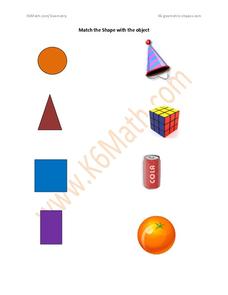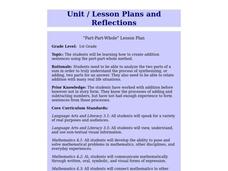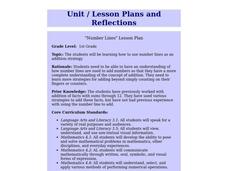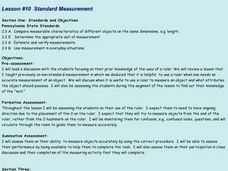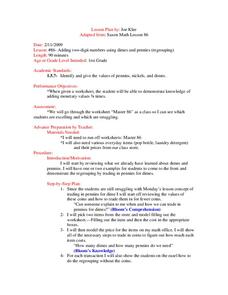Curated OER
Reviewing Facts Through 10
Manipulatives are always fun for children to use. They use connecting cubes and blocks to solve addition and subtraction word problems with numbers up to 10. They then play a math game and use their cube to create number sentences....
Curated OER
Leaf Patterns
First graders explore the existence of patterns in everyday items. In this science and math integrated lesson, 1st graders match leaves with a name word card and organize them into four patterns. This lesson includes a reading of And the...
Curated OER
Match the Shape
In this visual discrimination activity, students match the circle, triangle, rectangle, and square to the appropriate everyday objects that have those shapes.
Curated OER
An Introduction to Simple Machines
Students investigate simple machines and their uses in everyday life. In this scientific method instructional activity, students examine physical tools such as wedges, screws, and levers using a "how does it work" approach....
Curated OER
Whole Language Approach in Solving Word Problems
Students explore the concept of word problems. In this word problems lesson, students read a version of the Three Little Pigs. Students discuss what math vocabulary words such as 'in all' and 'many more' meant in the story.
Curated OER
Part-Part-Whole
First graders work with partners, using cubes to make addition sentences. In this math lesson, 1st graders separate cubes into 2 parts and discuss the relationship to addition sentences. Students practice separating cubes. Students make...
Curated OER
Number Lines
First graders examine the number line as an addition strategy. In this math lesson, 1st graders create a number line and use it to help them solve addition problems.
Curated OER
Where in the World is Tacky the Penguin?
First graders complete activities related to they story they are reading in class. Through art and measurement activities, 1st graders relate a story from the "Tacky the Penguin Series" to everyday objects and ideas they encounter.
Curated OER
Guesstimate? NO Estimate!
Students discover the advantage of estimation over simple guessing using number relationships. They also discover how useful a mathematical tool estimation is in everyday life.
Curated OER
Pattern Makers
Students are introduced to the notion of a repeating pattern. This is done by a number of means including the use of everyday objects. They are encouraged to create, describe and continue patterns.
Curated OER
Money Math
Young scholars investigate the characteristics of the different coins. The teacher presents each coin, and the students identify the distinguishing characteristics of each side of the coin, and the value of each coin. The young...
Curated OER
Part Part Whole
First graders solve number sentences. In this problem solving activity, 1st graders construct addition sentences using a part part whole mat. Students demonstrate problem solving strategies using cubes.
Texas Commission on the Arts
The Quarter Fold
Little ones identify the US quarter and explore the concept of one-fourth or one-quarter. Using real coins or coin manipulatives, they divide a square piece of paper into quarters, discuss halves and quarters, and create a design that...
Curated OER
Hibernating Hoopla
Students simulate hibernation with their stuffed animals. They predict the length of time of hibernation and type their math journal entries about sorting, graphing and draw pictures. They read bear hibernation stories.
Curated OER
Graphing It Daily
Students identify and demonstrate a positive learning attitude and use basic concepts and skills. Learners also communicate clearly in oral, artistic, written, and nonverbal form. Finally, students participate in the daily data...
Curated OER
Lesson #10 Standard Measurement
Learners are introduced to units of measurement found on a ruler as well as what attributes make an object difficult or easier to measure with a ruler. The teacher has various objects placed around the room, and the youngsters practice...
Curated OER
So Many Cats!
First graders listen to the book, So Many Cats, and discuss the number of cats in the story. They demonstrate simple addition problems using cat counters and a work mat in the shape of a house.
Curated OER
The Shape of Things
As young learners listen to the story The Shape of Things, by Dayle Ann Dodds, they see how shapes can be found all around us. On a provided worksheet, scholars choose a shape, then make it into a picture. They add details, and...
Curated OER
Tri this Angle!
First graders draw and describe various types of polygons. they investigate their own environments for examples of polygons. After reading the book, The Greedy Triangle, they discuss everyday objects that are polygons. They create shape...
Curated OER
Not Enough Drawers
Students describe three different categories to sort into. They sort these clothes into these three chosen categories. After asking questions the student divide the clothes.
Curated OER
Category Puzzle
In this vocabulary and word study worksheet, students categorize 8 everyday words as they use the 8 clues to correctly complete the crossword puzzle.
Curated OER
D.O.L.P.H.I.N. Binders
DOLPHIN—Daily Organizational Learning Portfolio and Handbook of Intelligent Note-taking. Here you'll find over 40 pages of templates, reference handouts, and instruction on ways pupils can organize their binders for a productive school...
Curated OER
Pizza Party
Students explore the concept of fractions through use of hands on activity. For this lesson about fractions, students will work together in small groups with a round piece of paper, or pizza, and cut the pizza into pieces. Students will...
Curated OER
Adding Two-Digit Numbers Using Dimes and Pennies
First graders examine regrouping when adding, by using dimes and pennies to borrow. In this addition lesson, 1st graders work together as a whole group, working together with the teacher.


